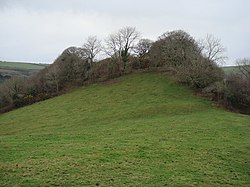Kilkhampton Castle
| Kilkhampton Castle | |
|
Cornwall | |
|---|---|
 Motte of Penstowe Castle | |
| Type: | Motte-and-bailey |
| Location | |
| Grid reference: | SS24261158 |
| Location: | 50°52’37"N, 4°29’58"W |
| Village: | Kilkhampton |
| History | |
| Built mid-12th century | |
| Information | |
| Condition: | Motte and earthworks remani |
| Owned by: | National Trust |
Kilkhampton Castle, otherwise known as Penstowe Castle, was a mediæval fortification built near Kilkhampton, Cornwall, possibly during the years of the civil war in the 12th century known as the Anarchy.
History
The precise date of Kilkhampton Castle's construction is uncertain, but it was built during the years of the Anarchy in the mid-12th century,[1] either by Robert, 1st Earl of Gloucester, feudal baron of Gloucester, who was certainly the tenant-in-chief of the manor of Kilkhampton, or by his tenants and relatives the Grenville family (possibly Sir Richard I de Grenville (d.post 1142) of Neath Castle, Glamorgan), which held the manor of Kilkhampton and the manor of Bideford in Devon from the Honour of Gloucester. Stowe House was the Grenvilles' residence at Kilkhampton, demolished and rebuilt in grand form in 1679 by John Granville, 1st Earl of Bath (1628-1701).
Kilkhampton Castle was built to a motte and bailey design, positioned on a knoll and protected by steep slopes on the north and south sides.[2] The motte today is shaped as an oval, 60 feet by 26 feet across and between 20 feet and 30 feet high; the inner bailey is 100 feet by 82 feet, and the outer bailey is 80 feet by 66 feet.[3] The configuration of baileys is unusual, although similar to nearby Eastleigh Berries Castle.[2] A D-shaped building was located on top of the motte.[4]
Archaeological excavations were carried out in 1925 and in the early 1950s.[4] In the 21st century the site is protected under law as a scheduled monument.[4]
Outside links
| ("Wikimedia Commons" has material about Penstowe Castle) |
References
- ↑ Preston-Jones & Rose 1986, p. 172
- ↑ 2.0 2.1 "Cornwall & Scilly HER". Heritage Gateway. http://www.heritagegateway.org.uk/Gateway/Results_Single.aspx?uid=MCO39452&resourceID=1020. Retrieved 13 January 2013.
- ↑ Preston-Jones & Rose 1986, p. 172; "Cornwall & Scilly HER". Heritage Gateway. http://www.heritagegateway.org.uk/Gateway/Results_Single.aspx?uid=MCO39452&resourceID=1020. Retrieved 13 January 2013.
- ↑ 4.0 4.1 4.2 National Heritage List 1003079: Kilkhampton Castle
- Preston-Jones, Anne; Rose, Peter (1986). "Mediæval Cornwall". Cornish Archaeology 25: 135–185.
